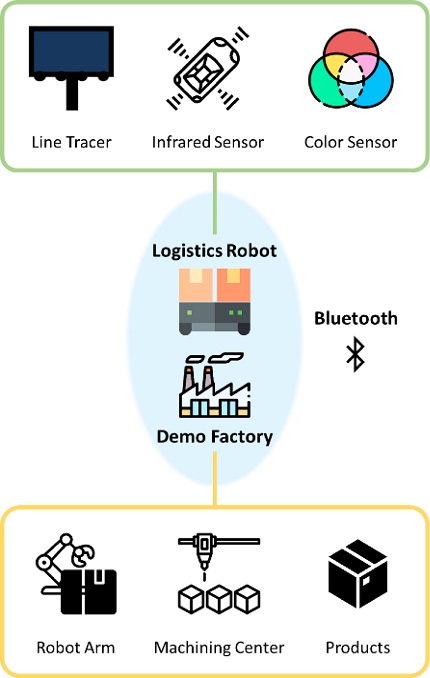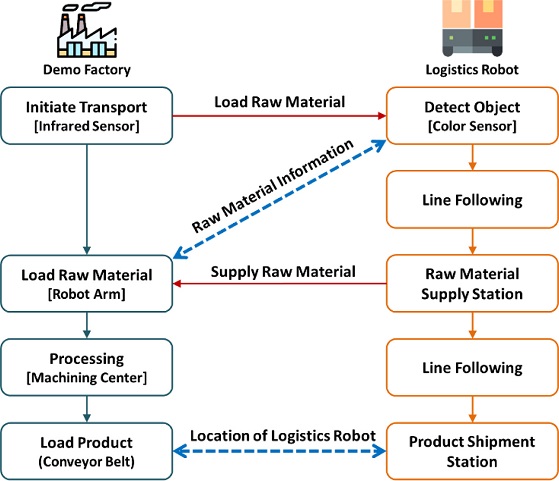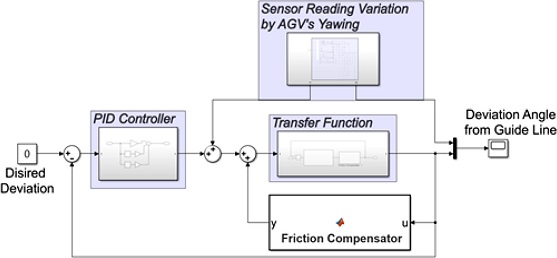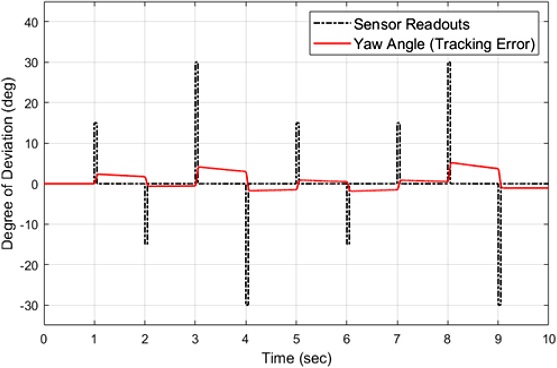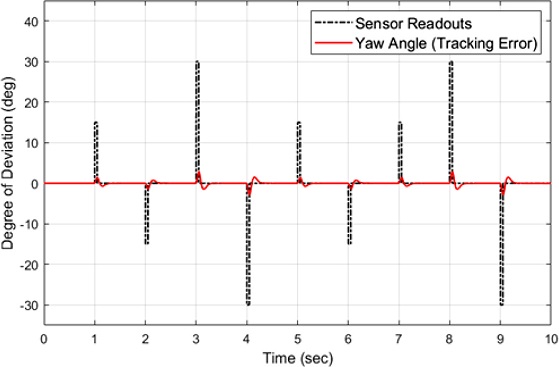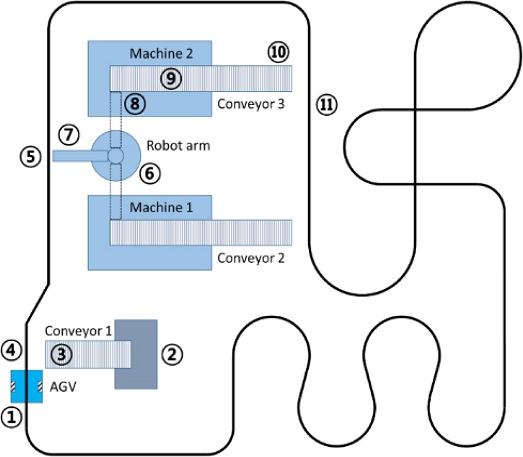
A Study on the Automated Guided Vehicle Platform for a Logistics Robot
Copyright © The Korean Society for Precision Engineering
This is an Open-Access article distributed under the terms of the Creative Commons Attribution Non-Commercial License (http://creativecommons.org/licenses/by-nc/3.0) which permits unrestricted non-commercial use, distribution, and reproduction in any medium, provided the original work is properly cited.
Abstract
The need for automated material handling inside the factory has been steadily increasing, especially due to implementation of intelligent manufacturing for better productivity and product quality. Automated material handling devices include logistics robots, automated guided vehicles, industrial robots, collaborative robots, and pick-and-place devices. This study focuses on the development of a low-cost logistics robot that works effectively within a simulated smart factory environment. A nominal PID controller is implemented to guide the robot to follow the line painted on the factory floor. The tracking error information is generated by four down-facing infrared sensors and is fed into the controller. The line-following performance is significantly improved with augmentation of a model-based friction compensator. Optimization of battery power depending on the remaining charge status enhances the reliability. All hardware/software development is supported by the Arduino platform. The step-by-step movement and performance of the logistics robot is verified inside the simulated smart factory environment that includes a robot arm, three conveyors, and two processing stations.
Keywords:
Logistics robot, Automated guided vehicle, Line tracer, PID controller, Friction compensator키워드:
물류로봇, 무인 운반차, 라인 트레이서, PID 제어기, 마찰 보상기1. Introduction
Logistics robots automate the process of storing and moving goods as they make their way through the supply chain. They’re often used in warehouses and storage facilities to organize and transport products, Logistics robots offer far greater levels of uptime over manual labor, leading to major productivity gains and profitability for those deploying logistics robots.
Logistics robots are also called AGV (Automated Guided Vehicle, AGV), LGV (Laser Guided Vehicle, LGV), and RGV (Rail Guided Vehicle, RGV) depending on the driving method. Major technologies related to logistics robots are largely classified as robot platform hardware, driving, recognition, manipulation, collaboration, usability and maintenance technologies. If the robot picks up directly, it can be introduced with minimal change to the existing warehouse environment and is cheaper than introducing automated warehouses, digital picking systems, conveyors, and AS/RS (Automated Storage and Retrial System, AS/RS).1-3
Even though there is a critical need for automated materials handling for particular operations, many companies are hesitant to introduce logistics robots due to limited capital and loss of production during conversion. This is the case for the most of small and medium sized factories. Hence there is need for a logistics robot running in autonomous fashion inside the factory without major changes in existing factory layout.4
In this study, we explore the opportunity to develop a low-cost logistics robot based on a testbed for autonomous vehicle development. The logistics robot typically follows a prescribed line or path on the factory floor. Hence a reliable control algorithm is required for line tracing (or Track-Following). We investigate the cause of any off-track incidents and suggest a method for improvement. A model factory that simulates smart factory operations is built and the performance of a logistics robot is verified through interaction with various components of the factory. The development effort is focused on utilization of various sensor information, optimization of battery power of the logistics robot and efficient communications between major elements.
2. Design and Fabrication of a Logistics Robot
2.1 Key Design Concepts
In terms of technologies and associated implementation issues for AGV and logistics robots, Wu and De, Hwang and Song, Raineri et al., presented well in their papers.5-7 Based on available technologies and components, we have built a prototype logistics robot. The overall dimension of a logistics robot has the width of 15 cm, the length of 15 cm, and the height of 12 cm. It is designed and fabricated as compact as possible by fitting all internal electronic and mechanical components. The robot is operated with two motorized wheels to minimize the movement envelope and turning radius during logistics operations. The main drive-train uses two DC (Direct Current, DC) motors with wheels positioned slightly ahead of the longitudinal center. This is intended to quickly respond to signals detected by the line tracer. Since the two drive wheels are located in front of the robot center, two small ball casters are installed in the rear in order to balance locomotion.
To activate line-tracking for a logistics robot, a black guideline is painted or taped to the factory floor. A line tracer composed of four infrared sensors that look down on the floor would detect guidelines and the robot will enact algorithms to follow the line.8 In the event of unexpected or unsafe driving situations such as erased guideline or an obstacle blocking the line, the collision avoidance algorithm keeps the robot a certain distance from the obstacle and guides the robot to move around the obstacle. In order to detect obstacles such as robot arms or conveyor systems inside the factory, three infrared sensors in the front, one at each side and one at the rear are installed.
Color sensors and Bluetooth modules are employed to determine the material transfer flow through real-time object detection and information sharing. Based on the detected object color that indicates material transfer logistics, the next tracking path of the logistics robot is determined.
The frame structure of the logistics robot is fabricated by 3D-printing technology. Polylactic acid (PLA) is laminated by the fused deposition modeling (FDM) method and the entire frame weighed about 300 grams.
2.2 Construction of a Model Factory and Description of System Architecture
A small demo factory with the size of 2.43 × 2.43 m2 has been constructed to demonstrate reliable navigation of the logistics robot and to simulate smart manufacturing processes that include information exchange through sensor integration, precise handling of raw and finished materials, sequential execution of production flow at the prescribed time stamps, and so on. Fig. 1 shows major components of a demo factory. Table 1 displays specific information regarding the components and sensors implemented for the demo factory and the logistics robot.
For reliable track-following, a line tracer with four infrared sensors is installed. Infrared sensors are also being used in the logistics robot and conveyor loading stations for detecting objects nearby. All relevant sensor data, location information of the logistics robot, and process steps are shared through real-time Bluetooth network. All these hardware and software development are done by utilizing two Arduino single board microprocessor architecture for both the robot arm and the logistics robot individually. For line following operation of the logistics robot, a typical PID (Proportional-Integral-Derivative, PID) controller is implemented.
The role of logistics robots is to transport raw materials or finished products to a desired station. The robot arm does a pick-and-place operation of raw materials transported by the logistics robot into a machining center or other processing equipment. After a desired processing is finished, the machining center indicates the completion of processing and the robot arm moves out the finished good onto the conveyor so that the logistics robot could carry the product to the shipment station. The flow chart of overall operations is displayed in Fig. 2.
For the purpose of demonstrating operations inside the demo factory, the materials processing station is symbolically marked as Machine 1 and Machine 2 in Fig. 8. The status of materials processing is indicated by color balls as shown in Fig. 9. The logistics robot and the demo factory exchange various signals and information through Bluetooth network. One of the critical information is to identify the color of the transported material (i.e., The Colored Ball) so that the logistics robot can be guided to the right station for the next process step. Once the logistics robot reaches the designated station, the demo factory would signal to start the next process.
2.3 Estimation of Transfer Functions of Logistics Robot
In order to estimate the transfer function of a logistics robot from the yaw angle to the input torque, a schematic diagram of Fig. 3 is used. The difference between the applied torque (Ti1 - Ti2) to two DC motors generates the rotational yaw angle θ of the logistics robot. Based on measured θ and the distance Ydev deviated from the centerline, the transfer function Gdev(s) is estimated as following:
| (1) |
In Eq. (1), Jw is the mass moment of inertia of wheels and drive motors, Bw is the viscous damping coefficient, rw and mw are the radius and mass of a wheel respectively, and Jf is the mass moment of inertia of all components of the logistics robot excluding the motor and wheels. l and lw are the distance from the center of the track to the wheel and to the center to the infrared sensor panel, respectively. The value of each parameter used in the transfer function is determined by either actual measurements or mathematical calculations.
In the case of logistics robot, disturbances such as friction in the drive unit and load weight changes occur due to the payload change, the PID control is not effective in removing these kinds of disturbances. Studies on friction force measurements, decomposition, modeling and compensation have been extensively conducted by various researchers.9-11 A friction compensator is introduced to solve the problem of road performance degradation caused by non-linear friction in the driving of logistics robot. The performance of friction compensators is verified by quantitative and qualitative evaluation based on simulation and actual experiments.
Accurate measurement and modeling of friction will make the system analysis easier and ultimately enable the friction compensation to improve the control system performance. Friction force versus angular velocity has been measured by varying input voltage to the motor control. Fig. 4 displays a curve-fitted friction model with critical values shown as Us+ = 613, Uc+ = 324; Us- = -535, Uc- = -287; V0+ = 11.4 cm/s, V0- = -12.1 cm/s, and the slope that is equivalent to the viscous friction coefficient as 25.6 units/(cm/s).15
3. Implementation for Experiments and Test Results
3.1 PID Control Simulation
Balaji, et al. proposed methods of optimizing PID controllers for line tracking robots.12 Patrick et al. presented techniques of line tracing for smooth driving.13 Fig. 5 shows a block diagram of the overall tracking control system that consists of a PID controller, a plant (i.e., A Logistics Robot), a friction compensator, and an external disturbance generator. For realistic simulation, the plant includes a nonlinear friction model shown in Fig. 4. The signals from four down-facing infrared sensors are equalized and feedback as off-track measurements from the line tracer. In order to evaluate the performance of the track-following controller, a rotational angle (θ) of 15 or 30o at the random interval is injected as a pulse disturbance. Here, the purpose of pulse disturbance is to simulate the situation when the robot deviates from the guideline at a certain moment during line-following.
The parameters of the PID controller are determined using MATLAB PID tuner tool so that the deviation from the center of the line of the desired path may converge to zero. The proportional, integral and differential control gains for simulations are selected as Kp = 3.8, Ki = 2.3 and Kd = 20, respectively.
3.2 Track-Following Performance Enhancement through Friction Compensation
Fig. 6 is the result of a track-following simulation of a logistics robot with the PID controller designed in the previous section. Spikes in the figure indicates disturbances coming into the logistics robot. Despite PID control effort, the tracking error does not quickly converge to zero and the big error of 4.17° at 9 s is observed due to nonlinear friction force included in the plant model for simulation. This is due to limitation of the PID controller that is not effective in compensating nonlinear components of friction forces such as coulomb friction and static friction (or Stiction).
Lee and Tomizuka, and Lee, et al. demonstrated friction modeling and compensation for precision motion control systems.14,15 A friction compensator shown in Fig. 5 is implemented in the velocity feedback loop and generates extra compensation signal for nonlinear friction component corresponding to the measured velocity. With friction compensator, the tracking errors have been significantly reduced to 0.0514° at 9 s-reduction of 98%.
3.3 Development of Track-Following Algorithm
The enhanced line-following controller with the friction compensation algorithm described in the previous section is implemented into an Arduino platform that is the main control hardware for the logistics robot. The following formula is used to convert the signals from four down-facing infrared sensors of the line tracer to the tracking error (or Off-Track) that indicates deviation from the centerline of the desired path.
| (2) |
Li represents the sensor readout value of the i-th sensor. Kn is the factor that would make the contribution of each sensor error term normalized to the predetermined value. For this application, we choose Kn = 10, and Ko = 25 that is the offset value corresponding to the center of the line. The sensors are numbered from left to right and the error value of zero indicates that the robot is exactly at the center of the line. Sensor readouts from four infrared sensors are combined by using Eq. (2) and categorized into 16 levels of off-track distance from the centerline.12
A nominal PID controller is implemented for track-following operations based on the sensor fusion algorithm shown in Eq. (2). The PID controller gains must be empirically determined due to uncertainty in the real plant. Even after many controller optimization attempts, the logistics robot wobbles considerably around the track with big off-track errors especially when minor disturbances are present. As we mentioned in Section 3.2, we suspect the cause of this phenomenon due to nonlinear friction components in the drive train. The PID gains are determined as following through MATLAB simulations after applying the nonlinear friction model in the plant and adding a friction compensator in the velocity feedback loop.
| (3) |
Friction compensation is based on the model shown in Fig. 4 and adds extra “kick” value into the drive motor based on the velocity estimation. 40% of the maximum motor input value is set as the default voltage adder.
Table 2 displays performance comparison of two controllers for experiments: one with a nominal PID controller and the other with PID controller + friction compensator. The experiment is conducted on the 50 cm straight line segment. During line-following operation, the alarm is sounded off when the infrared sensor #1 or #4 is triggered. This implies that excessive off-track is detected and the frequency is recorded as a “failure” in the table.
Before the improvement, the higher the basic driving speed of the logistics robot, the more excessive overshoot occurs, so the basic driving speed had to be set low to prevent this. However, after improving the controller, the basic driving speed was improved by preventing overshoot and enabling stable driving. This maximum speed is chosen empirically and as we see in the table, with application of the friction compensator, we are able to drive the system stably with 7% higher speed.
3.4 Compensation for Reduced Battery Charge and Output Voltage
Lithium-Ion or lithium-polymer type batteries exhibit the lower voltage output with increased battery usage time. This phenomenon is observed with the logistics robot especially when rapid voltage variations in drive motors are required to change the direction of motion.
If the output voltage varies according to the remaining battery charge amount, the line-following control system cannot work properly.
In order to compensate the motor output according to the battery charge amount, the output compensation factor (KB) is introduced. Experiments have confirmed that the battery produces about 80% of its normal output when the remaining battery charge is reduced to 70%. Just before the logistics robot starts its operation, it checks the level of the remaining battery charge, sets the compensation factor KB, and multiplies it to the motor output for extra boost. KB is experimentally determined by the following relation.
| (4) |
KB is set to 1.2 when the remaining battery capacity is 70%. The constant B is set depending on the remaining battery charge level. According to the battery level (0-100%), B is proportionally set to 0-1,000.
3.5 Demonstration of Logistics Robot Operations inside the Demo Factory
It is difficult to quantitatively compare apple-to-apple because the test conditions in the simulation and the test environment of the actual running line of the demo factory are not identical. As a result of applying the improved PID controller and friction compensator to the actual logistics robot based on the simulation result, the following performance was shown before and after the application of the improved controller when driving in a test factory. In the P-Turn course, the driving time was 19 seconds before improvement, but it was driven at 9 seconds after improvement. On the S-Turn course, the driving time was shortened from 27 seconds to 13 seconds after improvement.
Fig. 8 is a schematic diagram showing the overall layout of the demo factory. Each station number in Fig. 8 correspond to the numbered photo in Fig. 9. Incoming raw materials are transferred and processed in the order shown in Fig. 2. The logistics robot moves to each station at the designated time and the real-time information has been shared through Bluetooth network.
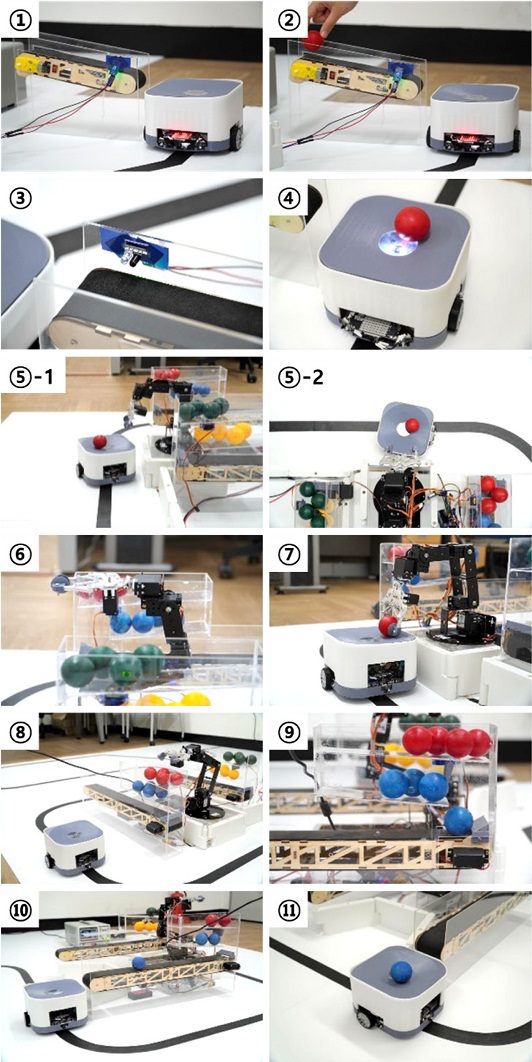
Demonstration of the logistics robot running inside the demo factory Refer to the demo video by J. Y. Jeong (September 1, 2020) https://www.youtube.com/watch?v=1xzqRBplMbw
The detailed description of each number is as following:
(1) When the logistics robot arrives at the warehouse, the infrared sensor on the right side of the logistics robot detects the warehouse and inputs a signal indicating that the logistics robot has arrived in the entire system.
(2) Raw materials (Red or Green Balls in Fig. 9) move from the warehouse to the logistics robot on the conveyor belt.
(3) When passing the infrared sensor located at the end of the conveyor belt, turn on the color sensor of the logistics robot.
(4) Check the color of raw materials through the color sensor of the logistics robot and determine the path of the logistics robot according to the color.
(5) The logistics robot stops when it enters the robot arm's motion radius.
(6) The robot arm prepares to put raw materials into one machining center based on the raw material color information.
(7) Transfer raw materials on the logistics robot.
(8) After the robot arm picks up the raw materials, the logistics robot starts again and goes to the place to receive the finished product and waits.
(9) While the logistics robot is moving, raw materials and finished products (Blue or Yellow Balls in Fig. 9) are exchanged inside the machining center.
(10) When the process is complete, the finished product moves along the conveyor belt to the logistics robot.
(11) The logistics robot loaded with the finished product follows the guidelines and drives toward the waiting area for delivery.
4. Conclusion
This paper presents a design of a low-cost logistics robot, enhanced control algorithms for track-following, and demonstration of navigation operations inside the smart factory. Simulated smart factory operations include materials transport by the logistics robot to a designated station, materials sorting based on color coding and identification, materials handling and processing by an industrial robot, logistic decision and routing based on the sensor information, and local networking through Bluetooth communications.
In order to improve line-following operations by the logistics robot, the PID control with the friction compensator is implemented and its effectiveness in various situations has been demonstrated. With implementation of a friction compensator, it is observed through MATLAB simulation that the tracking error has been reduced by 98%. It is also verified through experiments that the failure rate due to excessive off-track errors during track-following has been reduced by 83%. By monitoring the remaining charge capacity of battery, the output boost algorithm has been added in order to compensate reduced voltage output and this contributes to reliable performance of the logistics robot.
All these concepts of line-following based on sensors and a novel control algorithm and optimized battery operations have been successfully demonstrated inside the model plant. These logistics operations simulate a “smart factory” consisting of a logistics robot, three conveyor belts, two virtual process equipment, various sensors and Bluetooth-based network. This project is valuable not only for education of convergence technologies but also for development of a low-cost logistics solution for actual smart production.
Acknowledgments
This research is supported by Leaders in Industry-University Cooperation (LINC+) of Gyeongsang National University, National Research Foundation of Korea (NRF) Grant funded by the Korea government (MSIP, (No. NRF-2019R1C1C1005252)), and the fund of 2020 Undergraduate Research Program (URP), Korea Foundation for the Advancement of Science and Creativity.
REFERENCES
- Kim, K., Kim, J. H., and Choi, Y., “Logistics Robot Technology Trends and Future Prospects,” Korea Evaluation Institute of Industrial Technology, Vol. 17, No. 7, pp. 45-62, 2017.
-
Li, S., Yan, J., and Li, L., “Automated Guided Vehicle: The Direction of Intelligent Logistics,” Proc. of the IEEE International Conference on Service Operations and Logistics, and Informatics, pp. 250-255, 2018.
[https://doi.org/10.1109/SOLI.2018.8476726]

-
Mahadevan, B. and Narendran, T., “Design of an Automated Guided Vehicle-Based Material Handling System for a Flexible Manufacturing System,” The International Journal of Production Research, Vol. 28, No. 9, pp. 1611-1622, 1990.
[https://doi.org/10.1080/00207549008942819]

- Kim, J. A. and Jeong, J., “Smart Warehouse Management System Utilizing IoT-Based Autonomous Mobile Robot for SME Manufacturing Factory,” The Journal of the Institute of Internet, Broadcasting and Communication, Vol. 18, No. 5, pp. 237-244, 2018.
-
Wu, Y. and Ge, D., “Key Technologies of Warehousing Robot for Intelligent Logistics,” Proc. of the 1st International Symposium on Management and Social Sciences, Vol. 309, pp. 79-82, 2019.
[https://doi.org/10.2991/ismss-19.2019.16]

- Hwang, H. C. and Song, S. H., “A Study on the Factors Affecting the Acceptance of Logistics Robot in the Fulfillment Center Using the Technology Acceptance Model,” Journal of the Korea Academia-Industrial Cooperation Society, Vol. 20, No. 12, pp. 287-297, 2019.
-
Raineri, M., Perri, S., and Bianco, C. G. L., “Safety and Efficiency Management in LGV Operated Warehouses,” Robotics and Computer-Integrated Manufacturing, Vol. 57, pp. 73-85, 2019.
[https://doi.org/10.1016/j.rcim.2018.11.003]

- Choi, K. S. and Han, Y. H., “Implementing Line-Tracer Using Infrared Sensors,” Proceedings of Information-Communication Laboratory, Sangji University, Vol. 6, No. 1, pp. 7-10, 2010.
-
Armstrong-Hélouvry, B., Dupont, P., and De Wit, C. C., “A Survey of Models, Analysis Tools and Compensation Methods for the Control of Machines with Friction,” Automatica, Vol. 30, No. 7, pp. 1083-1138, 1994.
[https://doi.org/10.1016/0005-1098(94)90209-7]

-
De Wit, C. C., Olsson, H., Astrom, K. J., and Lischinsky, P., “A New Model for Control of Systems with Friction,” IEEE Transactions on Automatic Control, Vol. 40, No. 3, pp. 419-425, 1995.
[https://doi.org/10.1109/9.376053]

-
Dupont, P. E. and Dunlap, E. P., “Friction Modeling and PD Compensation at Very Low Velocities,” Journal of Dynamic Systems, Measurement and Control, Vol. 117, No. 1, pp. 8-14, 1995.
[https://doi.org/10.1115/1.2798527]

-
Balaji, V., Balaji, M., Chandrasekaran, M., and Elamvazuthi, I., “Optimization of PID Control for High Speed Line Tracking Robots,” Procedia Computer Science, Vol. 76, pp. 147-154, 2015.
[https://doi.org/10.1016/j.procs.2015.12.329]

-
Patrick, J., Banjao, P., Van Hecke, L., Lim, W., and Kim, M. S., “Line Tracing Technique for Smooth Driving,” International Journal of Innovative Technology and Exploring Engineering, Vol. 9, No. 1, pp. 2278-3075, 2019.
[https://doi.org/10.35940/ijitee.A4630.119119]

-
Lee, H. S. and Tomizuka, M., “Robust Motion Controller Design for High-Accuracy Positioning Systems,” IEEE Transactions on Industrial Electronics, Vol. 43, No. 1, pp. 48-55, 1996.
[https://doi.org/10.1109/41.481407]

-
Lee, H. S., Jung, S., and Ryu, S., “Performance Enhancement of Motion Control Systems through Friction Identification and Compensation,” Journal of the Korean Society of Manufacturing Process Engineers, Vol. 19, No. 6, pp. 1-8, 2020.
[https://doi.org/10.14775/ksmpe.2020.19.06.001]


Professor, Department of Mechanical Convergence Engineering, Gyeongsang National University. Received Ph.D. from Univ. of California at Berkeley. Research interests in precision motion control, system identification, mechatronics, and intelligent manufacturing systems.
E-mail: hoslee@gnu.ac.kr

B.Sc. candidate in the Department of Mechanical Convergence Engineering, Gyeongsang National University.
E-mail: ggp05066@naver.com
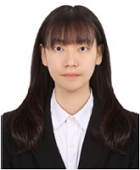
B.Sc. candidate in the Department of Mechanical Convergence Engineering, Gyeongsang National University.
E-mail: jaeyun0515@gmail.com

B.Sc. candidate in the Department of Mechanical Convergence Engineering, Gyeongsang National University.
E-mail: shryu2675@gmail.com

Assistant professor in the Department of Mechanical Convergence Engineering, Gyeongsang National University.
E-mail: wschu@gnu.ac.kr

